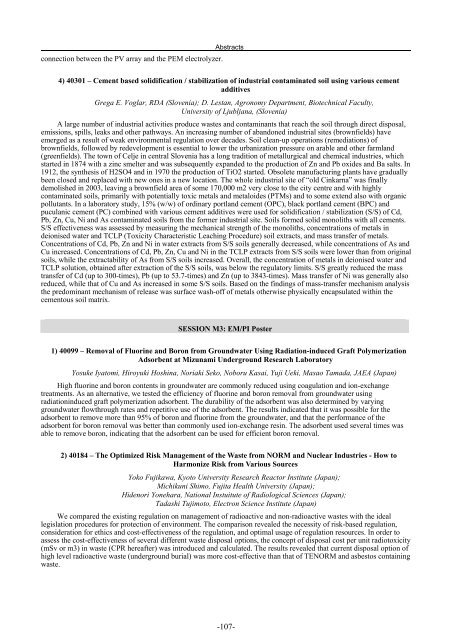ASME Message
ASME Message
ASME Message
You also want an ePaper? Increase the reach of your titles
YUMPU automatically turns print PDFs into web optimized ePapers that Google loves.
connection between the PV array and the PEM electrolyzer.<br />
Abstracts<br />
4) 40301 – Cement based solidification / stabilization of industrial contaminated soil using various cement<br />
additives<br />
Grega E. Voglar, RDA (Slovenia); D. Lestan, Agronomy Department, Biotechnical Faculty,<br />
University of Ljubljana, (Slovenia)<br />
A large number of industrial activities produce wastes and contaminants that reach the soil through direct disposal,<br />
emissions, spills, leaks and other pathways. An increasing number of abandoned industrial sites (brownfields) have<br />
emerged as a result of weak environmental regulation over decades. Soil clean-up operations (remediations) of<br />
brownfields, followed by redevelopment is essential to lower the urbanization pressure on arable and other farmland<br />
(greenfields). The town of Celje in central Slovenia has a long tradition of metallurgical and chemical industries, which<br />
started in 1874 with a zinc smelter and was subsequently expanded to the production of Zn and Pb oxides and Ba salts. In<br />
1912, the synthesis of H2SO4 and in 1970 the production of TiO2 started. Obsolete manufacturing plants have gradually<br />
been closed and replaced with new ones in a new location. The whole industrial site of “old Cinkarna” was finally<br />
demolished in 2003, leaving a brownfield area of some 170,000 m2 very close to the city centre and with highly<br />
contaminated soils, primarily with potentially toxic metals and metaloides (PTMs) and to some extend also with organic<br />
pollutants. In a laboratory study, 15% (w/w) of ordinary portland cement (OPC), black portland cement (BPC) and<br />
puculanic cement (PC) combined with various cement additives were used for solidification / stabilization (S/S) of Cd,<br />
Pb, Zn, Cu, Ni and As contaminated soils from the former industrial site. Soils formed solid monoliths with all cements.<br />
S/S effectiveness was assessed by measuring the mechanical strength of the monoliths, concentrations of metals in<br />
deionised water and TCLP (Toxicity Characteristic Leaching Procedure) soil extracts, and mass transfer of metals.<br />
Concentrations of Cd, Pb, Zn and Ni in water extracts from S/S soils generally decreased, while concentrations of As and<br />
Cu increased. Concentrations of Cd, Pb, Zn, Cu and Ni in the TCLP extracts from S/S soils were lower than from original<br />
soils, while the extractability of As from S/S soils increased. Overall, the concentration of metals in deionised water and<br />
TCLP solution, obtained after extraction of the S/S soils, was below the regulatory limits. S/S greatly reduced the mass<br />
transfer of Cd (up to 300-times), Pb (up to 53.7-times) and Zn (up to 3843-times). Mass transfer of Ni was generally also<br />
reduced, while that of Cu and As increased in some S/S soils. Based on the findings of mass-transfer mechanism analysis<br />
the predominant mechanism of release was surface wash-off of metals otherwise physically encapsulated within the<br />
cementous soil matrix.<br />
SESSION M3: EM/PI Poster<br />
1) 40099 – Removal of Fluorine and Boron from Groundwater Using Radiation-induced Graft Polymerization<br />
Adsorbent at Mizunami Underground Research Laboratory<br />
Yosuke Iyatomi, Hiroyuki Hoshina, Noriaki Seko, Noboru Kasai, Yuji Ueki, Masao Tamada, JAEA (Japan)<br />
High fluorine and boron contents in groundwater are commonly reduced using coagulation and ion-exchange<br />
treatments. As an alternative, we tested the efficiency of fluorine and boron removal from groundwater using<br />
radiationinduced graft polymerization adsorbent. The durability of the adsorbent was also determined by varying<br />
groundwater flowthrough rates and repetitive use of the adsorbent. The results indicated that it was possible for the<br />
adsorbent to remove more than 95% of boron and fluorine from the groundwater, and that the performance of the<br />
adsorbent for boron removal was better than commonly used ion-exchange resin. The adsorbent used several times was<br />
able to remove boron, indicating that the adsorbent can be used for efficient boron removal.<br />
2) 40184 – The Optimized Risk Management of the Waste from NORM and Nuclear Industries - How to<br />
Harmonize Risk from Various Sources<br />
Yoko Fujikawa, Kyoto University Research Reactor Institute (Japan);<br />
Michikuni Shimo, Fujita Health University (Japan);<br />
Hidenori Yonehara, National Instuitute of Radiological Sciences (Japan);<br />
Tadashi Tujimoto, Electron Science Institute (Japan)<br />
We compared the existing regulation on management of radioactive and non-radioactive wastes with the ideal<br />
legislation procedures for protection of environment. The comparison revealed the necessity of risk-based regulation,<br />
consideration for ethics and cost-effectiveness of the regulation, and optimal usage of regulation resources. In order to<br />
assess the cost-effectiveness of several different waste disposal options, the concept of disposal cost per unit radiotoxicity<br />
(mSv or m3) in waste (CPR hereafter) was introduced and calculated. The results revealed that current disposal option of<br />
high level radioactive waste (underground burial) was more cost-effective than that of TENORM and asbestos containing<br />
waste.<br />
-107-


